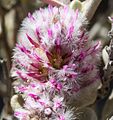Ptilotus
| Ptilotus | |
|---|---|

| |
| Ptilotus rotundifolius (F.Muell.) F.Muell. | |
| Scientific classification | |
| Kingdom: | Plantae |
| Clade: | Tracheophytes |
| Clade: | Angiosperms |
| Clade: | Eudicots |
| Order: | Caryophyllales |
| Family: | Amaranthaceae |
| Subfamily: | Amaranthoideae |
| Genus: | Ptilotus R.Br.[1] |
| Species | |
| Synonyms | |
Ptilotus R.Br. is a genus of approximately 120 species of annual and perennial herbs and shrubs in the family Amaranthaceae. All species are native to mainland Australia,[4][5][6] although one species, Ptilotus spathulatus (R.Br.) Poir., also occurs in Tasmania and another, R.Br., in Malesia on the islands of Flores and Timor.[7] Most of the diversity is in Western Australia, particularly in the Pilbara.[4][7][8] Common names for species in this genus include mulla mulla, foxtails, pussy tails and lamb's tails. The genus was first formally described by botanist Robert Brown in Prodromus Florae Novae Hollandiae in 1810.[1][4] In family-level phylogenetic studies, Ptilotus has been placed within a clade informally known as the 'aervoids'.[9] It has been resolved as monophyletic and is closely related to Aerva Forssk.[4][10] An interactive key to the species of Ptilotus is available at KeyBase.[11]
Species[]
Conservation status[]
A number of Ptilotus species are listed as threatened or priority flora in Western Australia:[8]
- T.Hammer & R.W.Davis, Priority 1
- Benl, Priority 2
- R.W.Davis, Priority 1
- Benl, Priority 3
- Benl, Priority 3
- F.Muell., Presumed Extinct
- (Diels) Schinz, Priority 1
- R.W.Davis, Priority 1
- R.W.Davis & T.Hammer, Priority 2
- Benl, Priority 1
- (F.Muell.) Benl, Priority 3
- Lally, Priority 1
- R.W.Davis & T.Hammer, Priority 1
- W.Fitzg., Priority 4
- Benl, Priority 3
- (Benl & H.Eichler) R.W.Davis, Priority 3
- Benl, Priority 2
- Benl, Priority 1
- Benl, Priority 4
- Benl, Priority 1
- Ptilotus pyramidatus (Moq.) F.Muell., Threatened (Declared Rare)
- Lally, Priority 1
- (Moq.) Benl, Priority 1
- R.W.Davis, Priority 3
- Benl, Priority 1
- Benl, Priority 4
- Benl, Priority 1
- R.W.Davis & T.Hammer, Priority 1
Gallery[]

Ptilotus exaltatus Nees

Ptilotus obovatus (Gaudich.) F.Muell.

(Gaudich.) F.Muell.

(Lindl.) F.Muell. subsp. stirlingii

Nees

(R.Br.) Poir.

Ptilotus nobilis (Lindl.) F.Muell

Benl

R.Br.

(Moq.) F.Muell.

T.Hammer & R.W.Davis

Ptilotus rotundifolius (F.Muell.) F.Muell.
References[]
| Wikimedia Commons has media related to Ptilotus. |
| Wikispecies has information related to Ptilotus. |
- ^ a b c Brown, R. (1810). Prodromus florae Novae Hollandiae et insulae Van-Diemen. London: Typis Richardi Taylor & Socii. p. 414. doi:10.5962/bhl.title.3678.
- ^ Black, J.M. (1948). Amaranthaceae: in Flora of South Australia, vol. 2. Adelaide: S.A. Government Printer. pp. 323–332.
- ^ Benl, G. (1990). "Further taxonomic studies in Australian Amaranthaceae". Mitt. Bot. Staatssamml. München. 29: 495–502.
- ^ a b c d Hammer, Timothy A.; Davis, Robert W.; Thiele, Kevin R. (2015). "A molecular framework phylogeny for Ptilotus (Amaranthaceae): Evidence for the rapid diversification of an arid Australian genus". Taxon. 64 (2): 272–285. doi:10.12705/642.6.
- ^ "Australian Plant Census". Council of Heads of Australasian Herbaria. Retrieved 2017-01-21.
- ^ "Nuytsia: 29: A key to Ptilotus (Amaranthaceae) in Western Australia". florabase.dpaw.wa.gov.au. Retrieved 2019-01-26.
- ^ a b "Ptilotus occurrence records". Australia's Virtual Herbarium. Council of Heads of Australasian Herbaria. Retrieved 2017-01-21.
- ^ a b "Ptilotus R.Br". FloraBase. Western Australian Herbarium. 8 September 2016. Retrieved 2017-01-21.
- ^ Müller, K.; Borsch, T. (2005). "Phylogenetics of Amaranthaceae based on matK/trnK sequence data: Evidence from parsimony, likelihood, and Bayesian analyses". Ann. Missouri Bot. Gard. 92: 66–102.
- ^ Sage, R.F.; Sage, T.L.; Pearcy, R.W.; Borsch, T. (2007). "The taxonomic distribution of C4 photosynthesis in Amaranthaceae sensu stricto". Am. J. Bot. 94 (12): 1992–2003. doi:10.3732/ajb.94.12.1992. PMID 21636394.
- ^ Hammer, Timothy A.; Davis, Robert W.; Thiele, Kevin R. (17 January 2017). "Species of Ptilotus". KeyBase: Flowering plants of Australia. Royal Botanic Gardens Victoria. Retrieved 27 January 2017.
- Ptilotus
- Amaranthaceae genera











